Analyzing Family Law's Significance in Societal Development & Progress
VerifiedAdded on 2022/09/16
|11
|2982
|12
Report
AI Summary
This assignment explores the critical role of family law in societal development, advancement, and the support of traditional family roles. It delves into family dynamics, policy influences, and key themes such as divorce, spousal rights, domestic violence, and intergenerational wealth transfer. The research outlines a plan to explore the complexities facing social policy framers in family law, and those involved in societal services and legal systems. It includes a preliminary outline of chapters discussing interpersonal realities within nuclear and disjointed families, the impact of family environment on children's wellbeing, and the role of family law in protecting spouses and children from abuse. The research methodology employs regression analysis to identify statistically significant causes of spousal abuse, considering factors like income, education, and mental stability. The conclusion emphasizes family law's importance to all segments of society and its broader impact beyond impoverished communities.
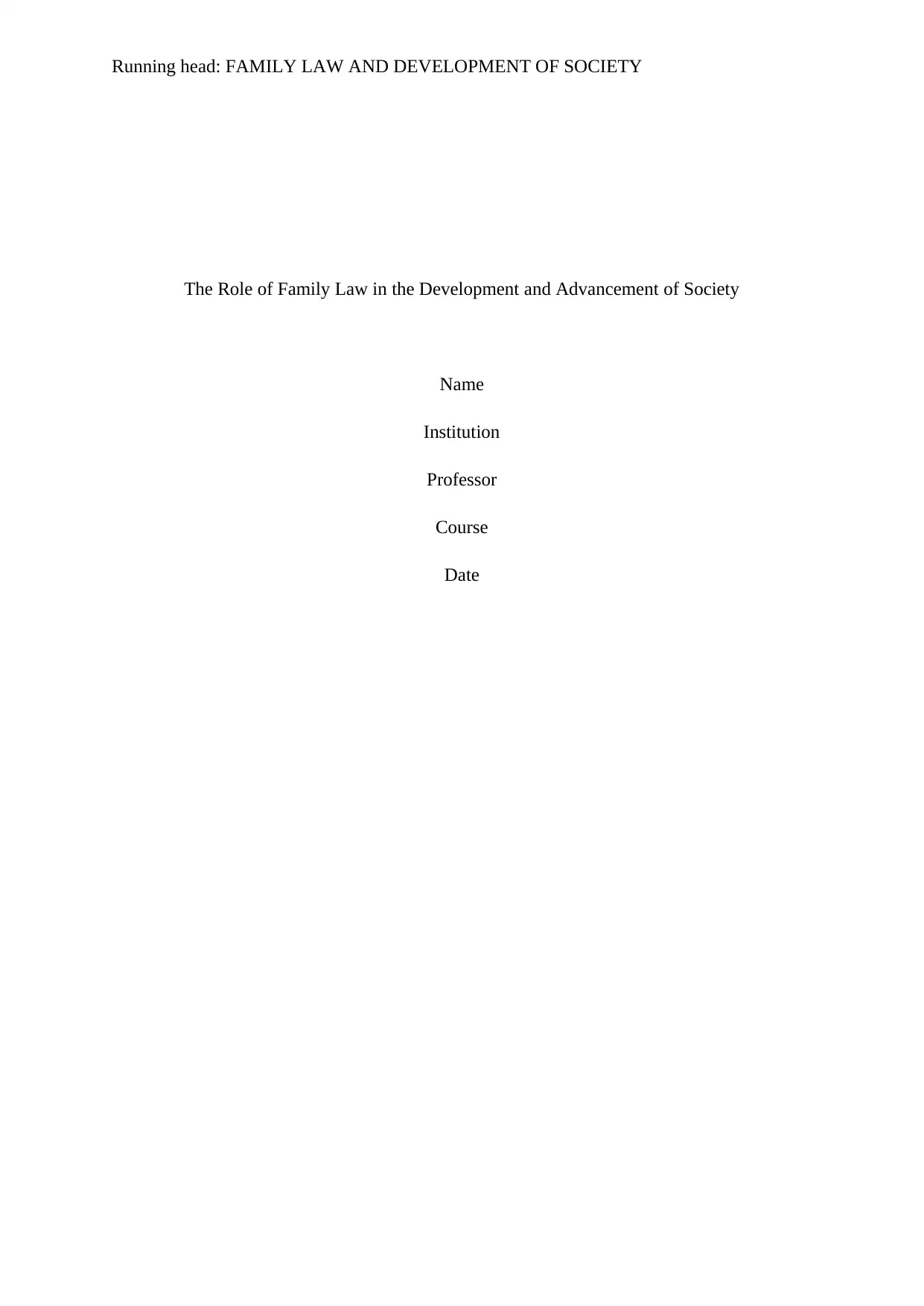
Running head: FAMILY LAW AND DEVELOPMENT OF SOCIETY
The Role of Family Law in the Development and Advancement of Society
Name
Institution
Professor
Course
Date
The Role of Family Law in the Development and Advancement of Society
Name
Institution
Professor
Course
Date
Paraphrase This Document
Need a fresh take? Get an instant paraphrase of this document with our AI Paraphraser
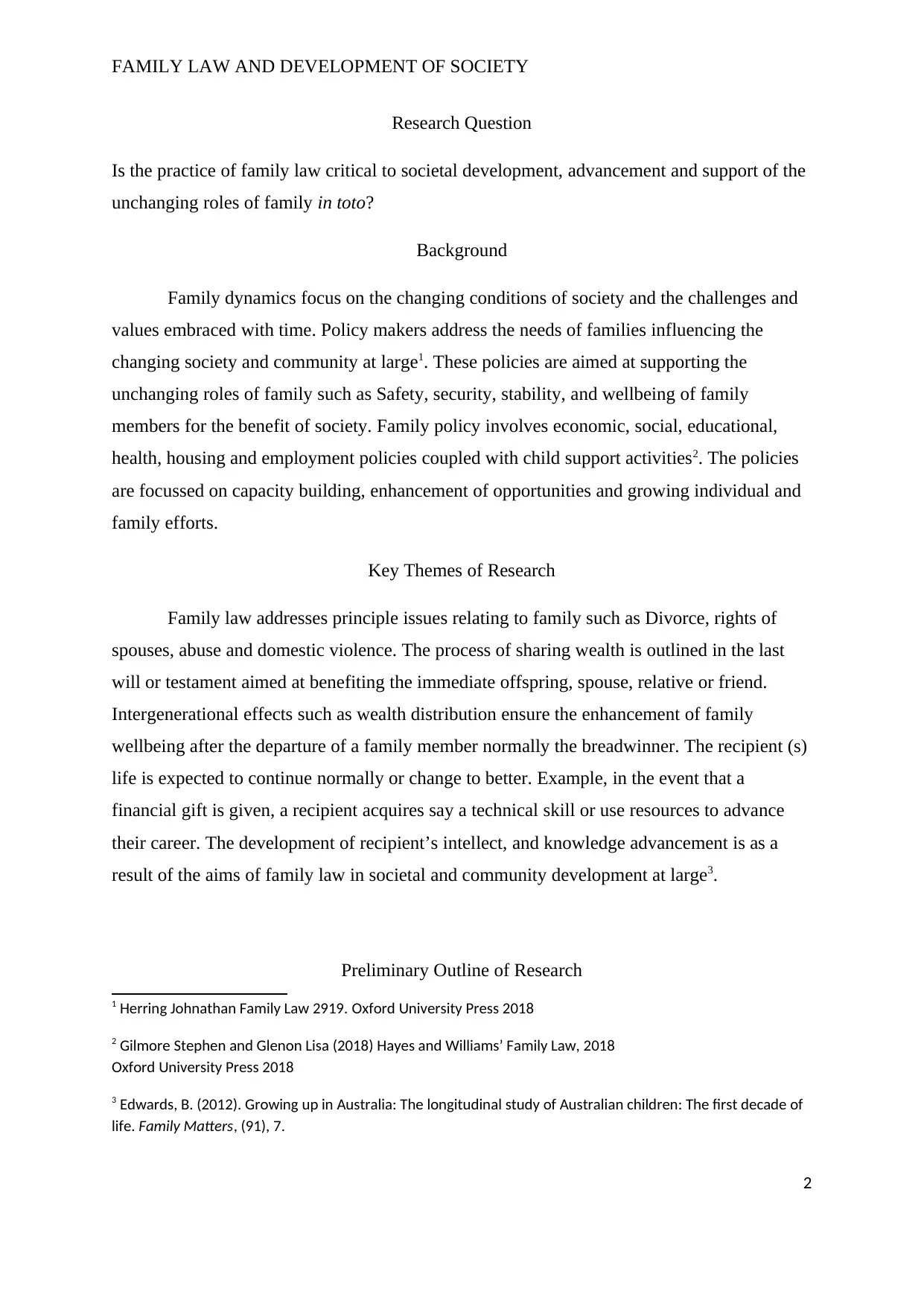
FAMILY LAW AND DEVELOPMENT OF SOCIETY
Research Question
Is the practice of family law critical to societal development, advancement and support of the
unchanging roles of family in toto?
Background
Family dynamics focus on the changing conditions of society and the challenges and
values embraced with time. Policy makers address the needs of families influencing the
changing society and community at large1. These policies are aimed at supporting the
unchanging roles of family such as Safety, security, stability, and wellbeing of family
members for the benefit of society. Family policy involves economic, social, educational,
health, housing and employment policies coupled with child support activities2. The policies
are focussed on capacity building, enhancement of opportunities and growing individual and
family efforts.
Key Themes of Research
Family law addresses principle issues relating to family such as Divorce, rights of
spouses, abuse and domestic violence. The process of sharing wealth is outlined in the last
will or testament aimed at benefiting the immediate offspring, spouse, relative or friend.
Intergenerational effects such as wealth distribution ensure the enhancement of family
wellbeing after the departure of a family member normally the breadwinner. The recipient (s)
life is expected to continue normally or change to better. Example, in the event that a
financial gift is given, a recipient acquires say a technical skill or use resources to advance
their career. The development of recipient’s intellect, and knowledge advancement is as a
result of the aims of family law in societal and community development at large3.
Preliminary Outline of Research
1 Herring Johnathan Family Law 2919. Oxford University Press 2018
2 Gilmore Stephen and Glenon Lisa (2018) Hayes and Williams’ Family Law, 2018
Oxford University Press 2018
3 Edwards, B. (2012). Growing up in Australia: The longitudinal study of Australian children: The first decade of
life. Family Matters, (91), 7.
2
Research Question
Is the practice of family law critical to societal development, advancement and support of the
unchanging roles of family in toto?
Background
Family dynamics focus on the changing conditions of society and the challenges and
values embraced with time. Policy makers address the needs of families influencing the
changing society and community at large1. These policies are aimed at supporting the
unchanging roles of family such as Safety, security, stability, and wellbeing of family
members for the benefit of society. Family policy involves economic, social, educational,
health, housing and employment policies coupled with child support activities2. The policies
are focussed on capacity building, enhancement of opportunities and growing individual and
family efforts.
Key Themes of Research
Family law addresses principle issues relating to family such as Divorce, rights of
spouses, abuse and domestic violence. The process of sharing wealth is outlined in the last
will or testament aimed at benefiting the immediate offspring, spouse, relative or friend.
Intergenerational effects such as wealth distribution ensure the enhancement of family
wellbeing after the departure of a family member normally the breadwinner. The recipient (s)
life is expected to continue normally or change to better. Example, in the event that a
financial gift is given, a recipient acquires say a technical skill or use resources to advance
their career. The development of recipient’s intellect, and knowledge advancement is as a
result of the aims of family law in societal and community development at large3.
Preliminary Outline of Research
1 Herring Johnathan Family Law 2919. Oxford University Press 2018
2 Gilmore Stephen and Glenon Lisa (2018) Hayes and Williams’ Family Law, 2018
Oxford University Press 2018
3 Edwards, B. (2012). Growing up in Australia: The longitudinal study of Australian children: The first decade of
life. Family Matters, (91), 7.
2
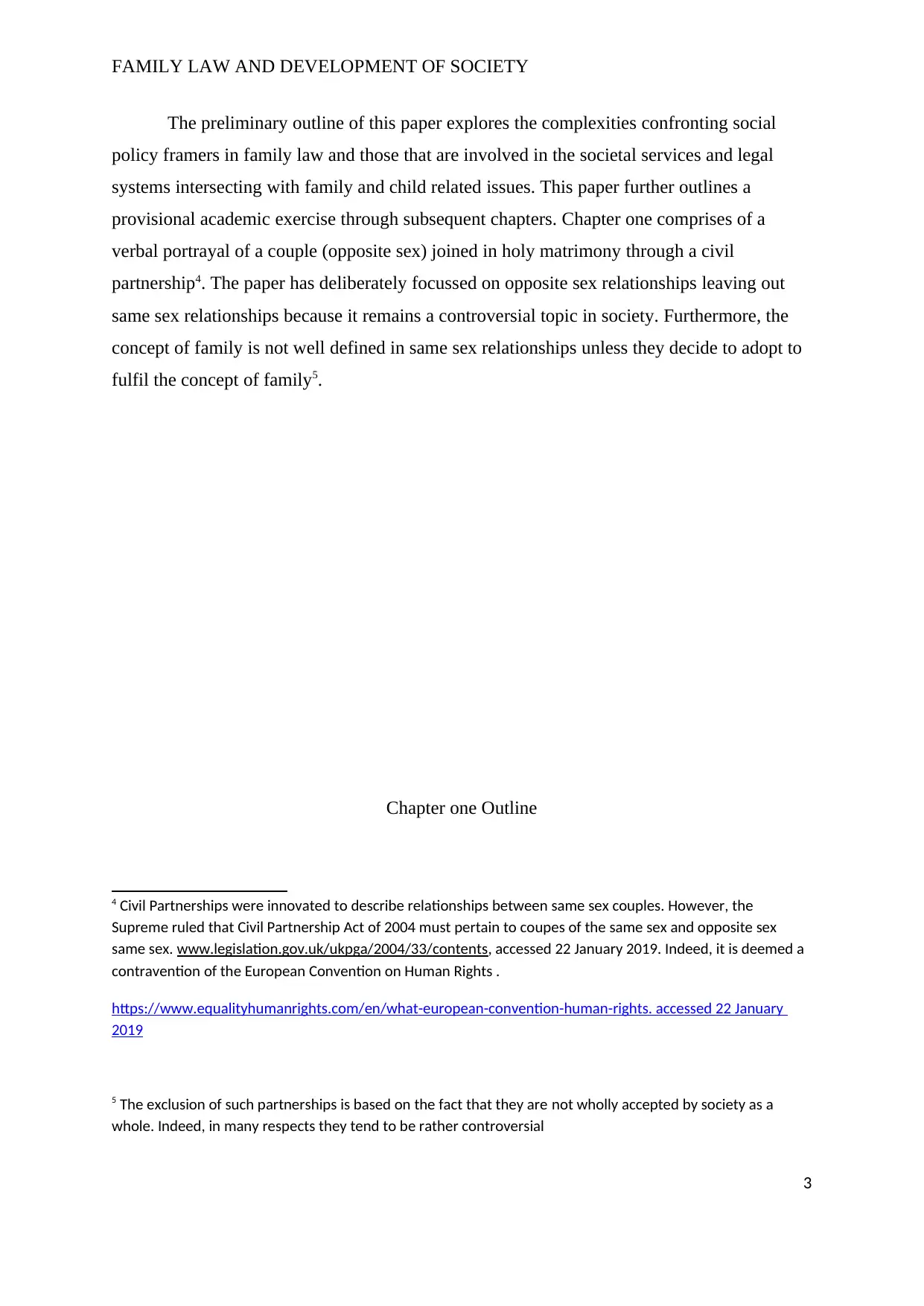
FAMILY LAW AND DEVELOPMENT OF SOCIETY
The preliminary outline of this paper explores the complexities confronting social
policy framers in family law and those that are involved in the societal services and legal
systems intersecting with family and child related issues. This paper further outlines a
provisional academic exercise through subsequent chapters. Chapter one comprises of a
verbal portrayal of a couple (opposite sex) joined in holy matrimony through a civil
partnership4. The paper has deliberately focussed on opposite sex relationships leaving out
same sex relationships because it remains a controversial topic in society. Furthermore, the
concept of family is not well defined in same sex relationships unless they decide to adopt to
fulfil the concept of family5.
Chapter one Outline
4 Civil Partnerships were innovated to describe relationships between same sex couples. However, the
Supreme ruled that Civil Partnership Act of 2004 must pertain to coupes of the same sex and opposite sex
same sex. www.legislation.gov.uk/ukpga/2004/33/contents, accessed 22 January 2019. Indeed, it is deemed a
contravention of the European Convention on Human Rights .
https://www.equalityhumanrights.com/en/what-european-convention-human-rights. accessed 22 January
2019
5 The exclusion of such partnerships is based on the fact that they are not wholly accepted by society as a
whole. Indeed, in many respects they tend to be rather controversial
3
The preliminary outline of this paper explores the complexities confronting social
policy framers in family law and those that are involved in the societal services and legal
systems intersecting with family and child related issues. This paper further outlines a
provisional academic exercise through subsequent chapters. Chapter one comprises of a
verbal portrayal of a couple (opposite sex) joined in holy matrimony through a civil
partnership4. The paper has deliberately focussed on opposite sex relationships leaving out
same sex relationships because it remains a controversial topic in society. Furthermore, the
concept of family is not well defined in same sex relationships unless they decide to adopt to
fulfil the concept of family5.
Chapter one Outline
4 Civil Partnerships were innovated to describe relationships between same sex couples. However, the
Supreme ruled that Civil Partnership Act of 2004 must pertain to coupes of the same sex and opposite sex
same sex. www.legislation.gov.uk/ukpga/2004/33/contents, accessed 22 January 2019. Indeed, it is deemed a
contravention of the European Convention on Human Rights .
https://www.equalityhumanrights.com/en/what-european-convention-human-rights. accessed 22 January
2019
5 The exclusion of such partnerships is based on the fact that they are not wholly accepted by society as a
whole. Indeed, in many respects they tend to be rather controversial
3
⊘ This is a preview!⊘
Do you want full access?
Subscribe today to unlock all pages.

Trusted by 1+ million students worldwide
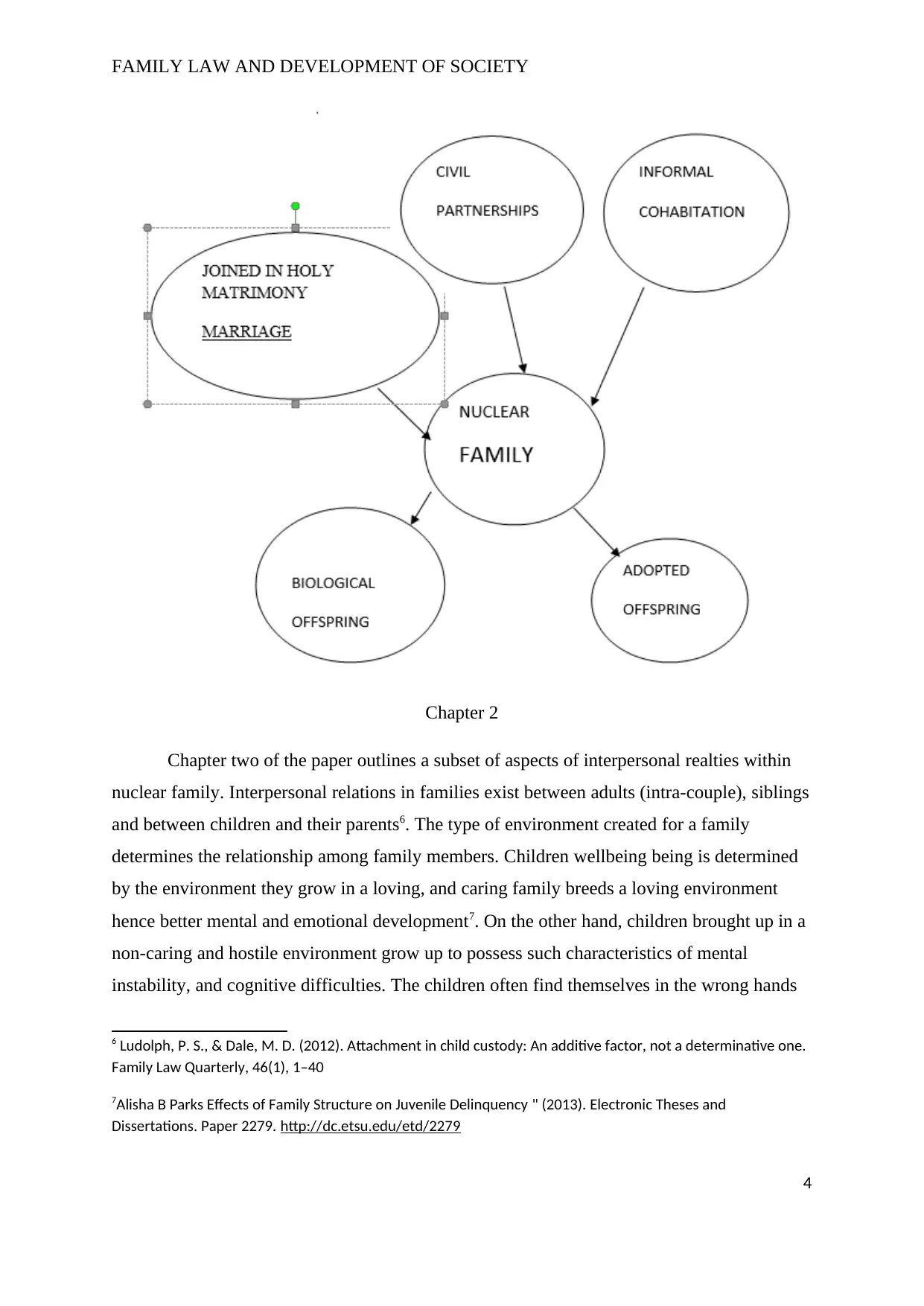
FAMILY LAW AND DEVELOPMENT OF SOCIETY
Chapter 2
Chapter two of the paper outlines a subset of aspects of interpersonal realties within
nuclear family. Interpersonal relations in families exist between adults (intra-couple), siblings
and between children and their parents6. The type of environment created for a family
determines the relationship among family members. Children wellbeing being is determined
by the environment they grow in a loving, and caring family breeds a loving environment
hence better mental and emotional development7. On the other hand, children brought up in a
non-caring and hostile environment grow up to possess such characteristics of mental
instability, and cognitive difficulties. The children often find themselves in the wrong hands
6 Ludolph, P. S., & Dale, M. D. (2012). Attachment in child custody: An additive factor, not a determinative one.
Family Law Quarterly, 46(1), 1–40
7Alisha B Parks Effects of Family Structure on Juvenile Delinquency " (2013). Electronic Theses and
Dissertations. Paper 2279. http://dc.etsu.edu/etd/2279
4
Chapter 2
Chapter two of the paper outlines a subset of aspects of interpersonal realties within
nuclear family. Interpersonal relations in families exist between adults (intra-couple), siblings
and between children and their parents6. The type of environment created for a family
determines the relationship among family members. Children wellbeing being is determined
by the environment they grow in a loving, and caring family breeds a loving environment
hence better mental and emotional development7. On the other hand, children brought up in a
non-caring and hostile environment grow up to possess such characteristics of mental
instability, and cognitive difficulties. The children often find themselves in the wrong hands
6 Ludolph, P. S., & Dale, M. D. (2012). Attachment in child custody: An additive factor, not a determinative one.
Family Law Quarterly, 46(1), 1–40
7Alisha B Parks Effects of Family Structure on Juvenile Delinquency " (2013). Electronic Theses and
Dissertations. Paper 2279. http://dc.etsu.edu/etd/2279
4
Paraphrase This Document
Need a fresh take? Get an instant paraphrase of this document with our AI Paraphraser
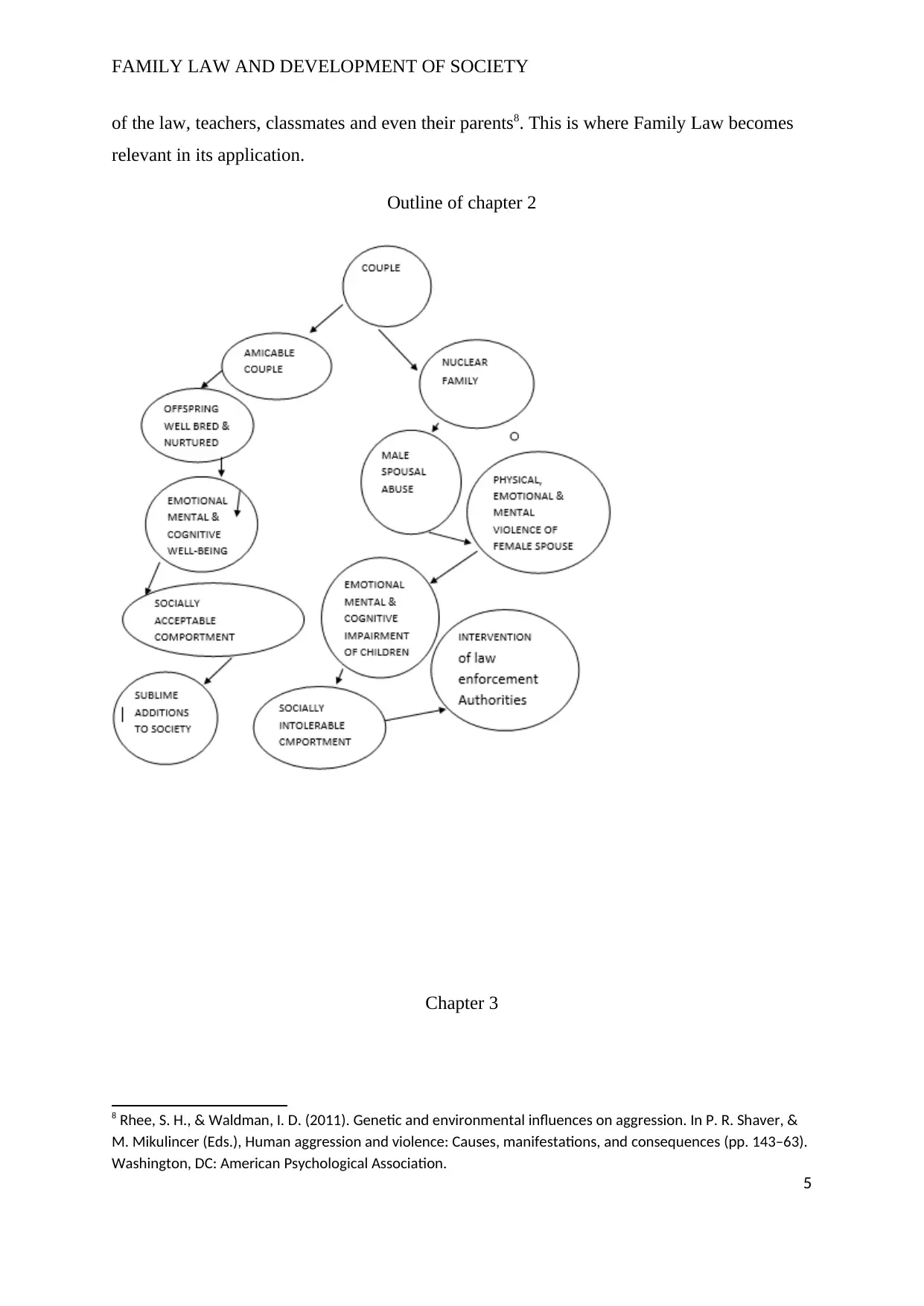
FAMILY LAW AND DEVELOPMENT OF SOCIETY
of the law, teachers, classmates and even their parents8. This is where Family Law becomes
relevant in its application.
Outline of chapter 2
Chapter 3
8 Rhee, S. H., & Waldman, I. D. (2011). Genetic and environmental influences on aggression. In P. R. Shaver, &
M. Mikulincer (Eds.), Human aggression and violence: Causes, manifestations, and consequences (pp. 143–63).
Washington, DC: American Psychological Association.
5
of the law, teachers, classmates and even their parents8. This is where Family Law becomes
relevant in its application.
Outline of chapter 2
Chapter 3
8 Rhee, S. H., & Waldman, I. D. (2011). Genetic and environmental influences on aggression. In P. R. Shaver, &
M. Mikulincer (Eds.), Human aggression and violence: Causes, manifestations, and consequences (pp. 143–63).
Washington, DC: American Psychological Association.
5
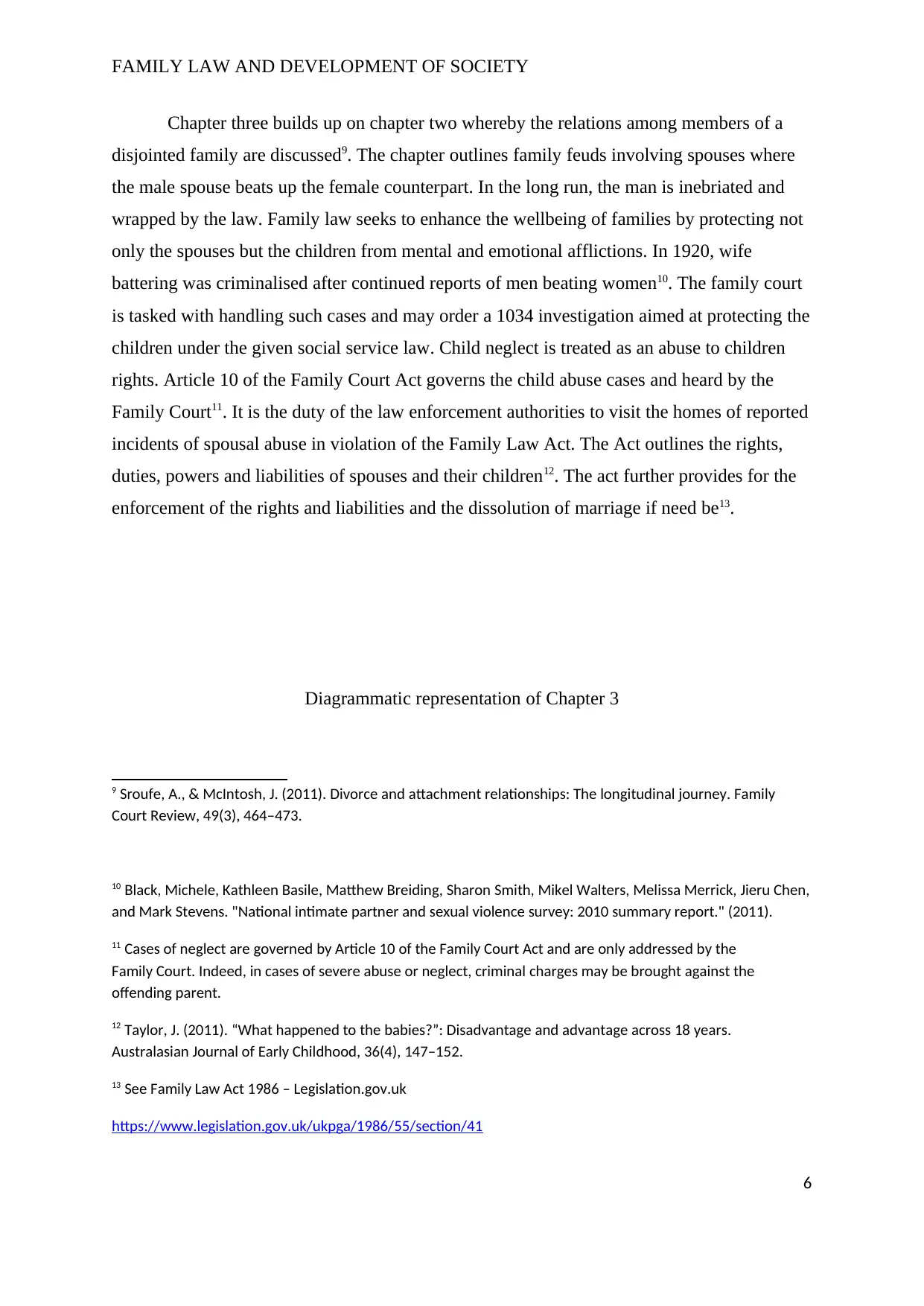
FAMILY LAW AND DEVELOPMENT OF SOCIETY
Chapter three builds up on chapter two whereby the relations among members of a
disjointed family are discussed9. The chapter outlines family feuds involving spouses where
the male spouse beats up the female counterpart. In the long run, the man is inebriated and
wrapped by the law. Family law seeks to enhance the wellbeing of families by protecting not
only the spouses but the children from mental and emotional afflictions. In 1920, wife
battering was criminalised after continued reports of men beating women10. The family court
is tasked with handling such cases and may order a 1034 investigation aimed at protecting the
children under the given social service law. Child neglect is treated as an abuse to children
rights. Article 10 of the Family Court Act governs the child abuse cases and heard by the
Family Court11. It is the duty of the law enforcement authorities to visit the homes of reported
incidents of spousal abuse in violation of the Family Law Act. The Act outlines the rights,
duties, powers and liabilities of spouses and their children12. The act further provides for the
enforcement of the rights and liabilities and the dissolution of marriage if need be13.
Diagrammatic representation of Chapter 3
9 Sroufe, A., & McIntosh, J. (2011). Divorce and attachment relationships: The longitudinal journey. Family
Court Review, 49(3), 464–473.
10 Black, Michele, Kathleen Basile, Matthew Breiding, Sharon Smith, Mikel Walters, Melissa Merrick, Jieru Chen,
and Mark Stevens. "National intimate partner and sexual violence survey: 2010 summary report." (2011).
11 Cases of neglect are governed by Article 10 of the Family Court Act and are only addressed by the
Family Court. Indeed, in cases of severe abuse or neglect, criminal charges may be brought against the
offending parent.
12 Taylor, J. (2011). “What happened to the babies?”: Disadvantage and advantage across 18 years.
Australasian Journal of Early Childhood, 36(4), 147–152.
13 See Family Law Act 1986 – Legislation.gov.uk
https://www.legislation.gov.uk/ukpga/1986/55/section/41
6
Chapter three builds up on chapter two whereby the relations among members of a
disjointed family are discussed9. The chapter outlines family feuds involving spouses where
the male spouse beats up the female counterpart. In the long run, the man is inebriated and
wrapped by the law. Family law seeks to enhance the wellbeing of families by protecting not
only the spouses but the children from mental and emotional afflictions. In 1920, wife
battering was criminalised after continued reports of men beating women10. The family court
is tasked with handling such cases and may order a 1034 investigation aimed at protecting the
children under the given social service law. Child neglect is treated as an abuse to children
rights. Article 10 of the Family Court Act governs the child abuse cases and heard by the
Family Court11. It is the duty of the law enforcement authorities to visit the homes of reported
incidents of spousal abuse in violation of the Family Law Act. The Act outlines the rights,
duties, powers and liabilities of spouses and their children12. The act further provides for the
enforcement of the rights and liabilities and the dissolution of marriage if need be13.
Diagrammatic representation of Chapter 3
9 Sroufe, A., & McIntosh, J. (2011). Divorce and attachment relationships: The longitudinal journey. Family
Court Review, 49(3), 464–473.
10 Black, Michele, Kathleen Basile, Matthew Breiding, Sharon Smith, Mikel Walters, Melissa Merrick, Jieru Chen,
and Mark Stevens. "National intimate partner and sexual violence survey: 2010 summary report." (2011).
11 Cases of neglect are governed by Article 10 of the Family Court Act and are only addressed by the
Family Court. Indeed, in cases of severe abuse or neglect, criminal charges may be brought against the
offending parent.
12 Taylor, J. (2011). “What happened to the babies?”: Disadvantage and advantage across 18 years.
Australasian Journal of Early Childhood, 36(4), 147–152.
13 See Family Law Act 1986 – Legislation.gov.uk
https://www.legislation.gov.uk/ukpga/1986/55/section/41
6
⊘ This is a preview!⊘
Do you want full access?
Subscribe today to unlock all pages.

Trusted by 1+ million students worldwide
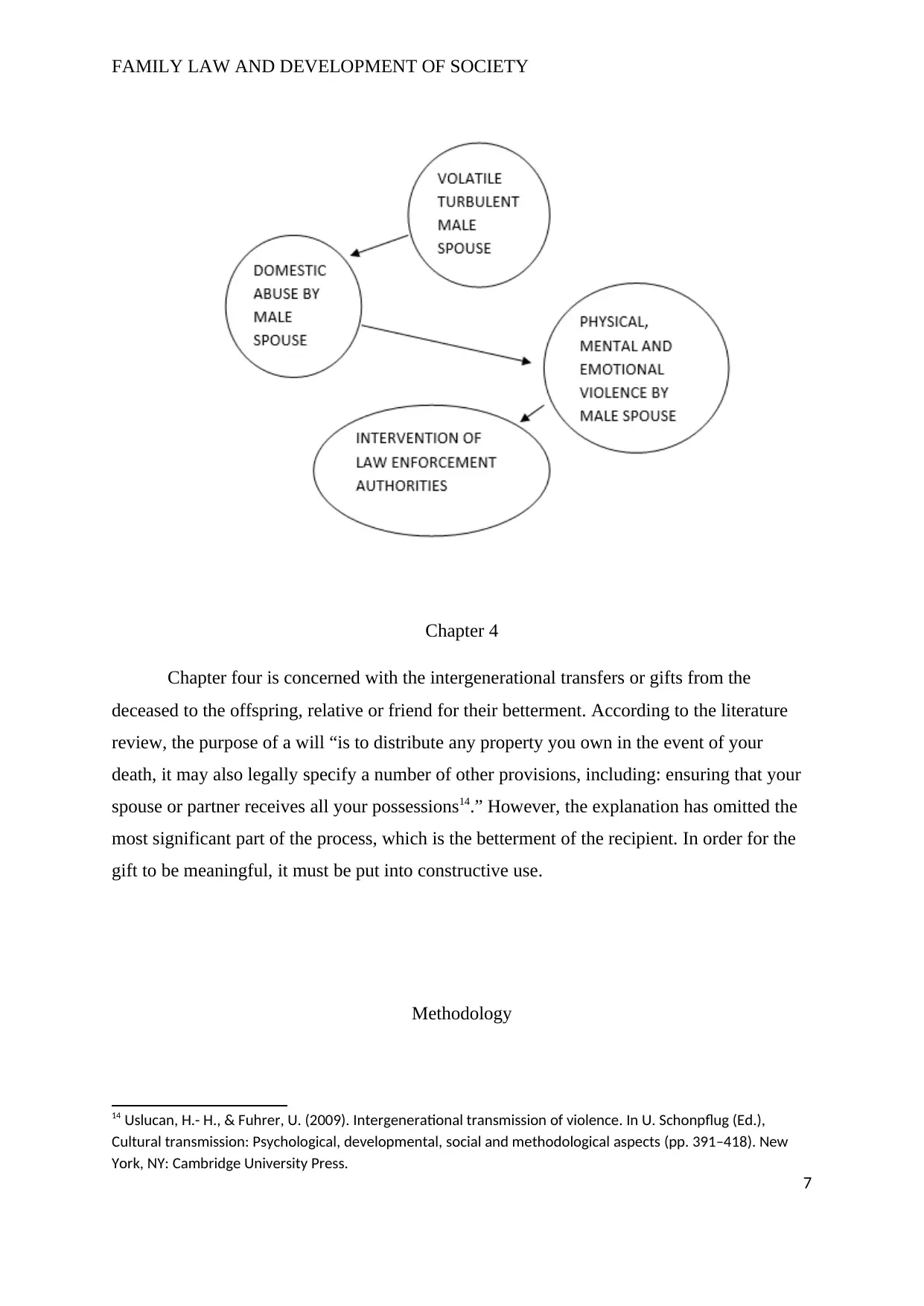
FAMILY LAW AND DEVELOPMENT OF SOCIETY
Chapter 4
Chapter four is concerned with the intergenerational transfers or gifts from the
deceased to the offspring, relative or friend for their betterment. According to the literature
review, the purpose of a will “is to distribute any property you own in the event of your
death, it may also legally specify a number of other provisions, including: ensuring that your
spouse or partner receives all your possessions14.” However, the explanation has omitted the
most significant part of the process, which is the betterment of the recipient. In order for the
gift to be meaningful, it must be put into constructive use.
Methodology
14 Uslucan, H.- H., & Fuhrer, U. (2009). Intergenerational transmission of violence. In U. Schonpflug (Ed.),
Cultural transmission: Psychological, developmental, social and methodological aspects (pp. 391–418). New
York, NY: Cambridge University Press.
7
Chapter 4
Chapter four is concerned with the intergenerational transfers or gifts from the
deceased to the offspring, relative or friend for their betterment. According to the literature
review, the purpose of a will “is to distribute any property you own in the event of your
death, it may also legally specify a number of other provisions, including: ensuring that your
spouse or partner receives all your possessions14.” However, the explanation has omitted the
most significant part of the process, which is the betterment of the recipient. In order for the
gift to be meaningful, it must be put into constructive use.
Methodology
14 Uslucan, H.- H., & Fuhrer, U. (2009). Intergenerational transmission of violence. In U. Schonpflug (Ed.),
Cultural transmission: Psychological, developmental, social and methodological aspects (pp. 391–418). New
York, NY: Cambridge University Press.
7
Paraphrase This Document
Need a fresh take? Get an instant paraphrase of this document with our AI Paraphraser
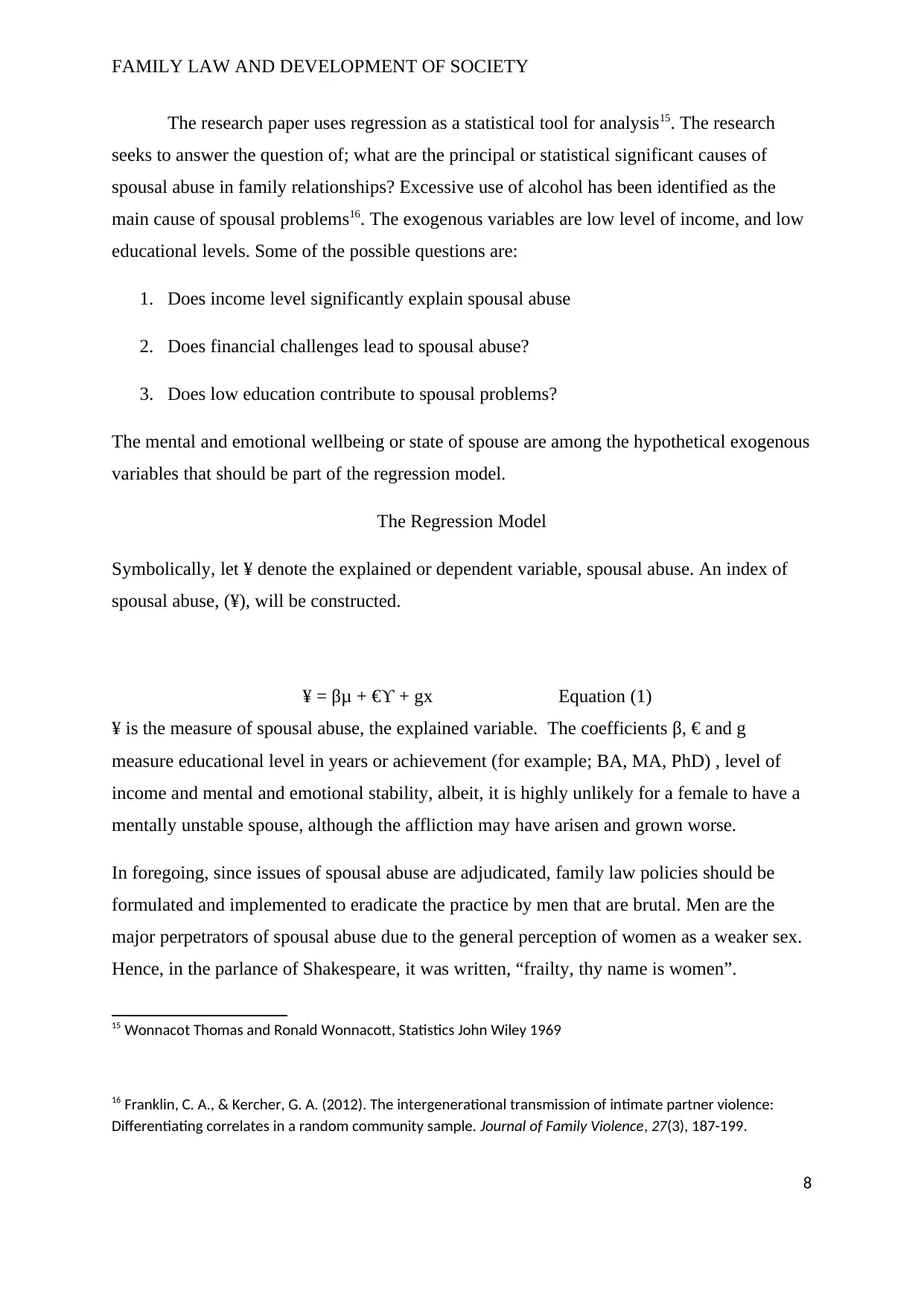
FAMILY LAW AND DEVELOPMENT OF SOCIETY
The research paper uses regression as a statistical tool for analysis15. The research
seeks to answer the question of; what are the principal or statistical significant causes of
spousal abuse in family relationships? Excessive use of alcohol has been identified as the
main cause of spousal problems16. The exogenous variables are low level of income, and low
educational levels. Some of the possible questions are:
1. Does income level significantly explain spousal abuse
2. Does financial challenges lead to spousal abuse?
3. Does low education contribute to spousal problems?
The mental and emotional wellbeing or state of spouse are among the hypothetical exogenous
variables that should be part of the regression model.
The Regression Model
Symbolically, let ¥ denote the explained or dependent variable, spousal abuse. An index of
spousal abuse, (¥), will be constructed.
¥ = βμ + €ϒ + gx Equation (1)
¥ is the measure of spousal abuse, the explained variable. The coefficients β, € and g
measure educational level in years or achievement (for example; BA, MA, PhD) , level of
income and mental and emotional stability, albeit, it is highly unlikely for a female to have a
mentally unstable spouse, although the affliction may have arisen and grown worse.
In foregoing, since issues of spousal abuse are adjudicated, family law policies should be
formulated and implemented to eradicate the practice by men that are brutal. Men are the
major perpetrators of spousal abuse due to the general perception of women as a weaker sex.
Hence, in the parlance of Shakespeare, it was written, “frailty, thy name is women”.
15 Wonnacot Thomas and Ronald Wonnacott, Statistics John Wiley 1969
16 Franklin, C. A., & Kercher, G. A. (2012). The intergenerational transmission of intimate partner violence:
Differentiating correlates in a random community sample. Journal of Family Violence, 27(3), 187-199.
8
The research paper uses regression as a statistical tool for analysis15. The research
seeks to answer the question of; what are the principal or statistical significant causes of
spousal abuse in family relationships? Excessive use of alcohol has been identified as the
main cause of spousal problems16. The exogenous variables are low level of income, and low
educational levels. Some of the possible questions are:
1. Does income level significantly explain spousal abuse
2. Does financial challenges lead to spousal abuse?
3. Does low education contribute to spousal problems?
The mental and emotional wellbeing or state of spouse are among the hypothetical exogenous
variables that should be part of the regression model.
The Regression Model
Symbolically, let ¥ denote the explained or dependent variable, spousal abuse. An index of
spousal abuse, (¥), will be constructed.
¥ = βμ + €ϒ + gx Equation (1)
¥ is the measure of spousal abuse, the explained variable. The coefficients β, € and g
measure educational level in years or achievement (for example; BA, MA, PhD) , level of
income and mental and emotional stability, albeit, it is highly unlikely for a female to have a
mentally unstable spouse, although the affliction may have arisen and grown worse.
In foregoing, since issues of spousal abuse are adjudicated, family law policies should be
formulated and implemented to eradicate the practice by men that are brutal. Men are the
major perpetrators of spousal abuse due to the general perception of women as a weaker sex.
Hence, in the parlance of Shakespeare, it was written, “frailty, thy name is women”.
15 Wonnacot Thomas and Ronald Wonnacott, Statistics John Wiley 1969
16 Franklin, C. A., & Kercher, G. A. (2012). The intergenerational transmission of intimate partner violence:
Differentiating correlates in a random community sample. Journal of Family Violence, 27(3), 187-199.
8
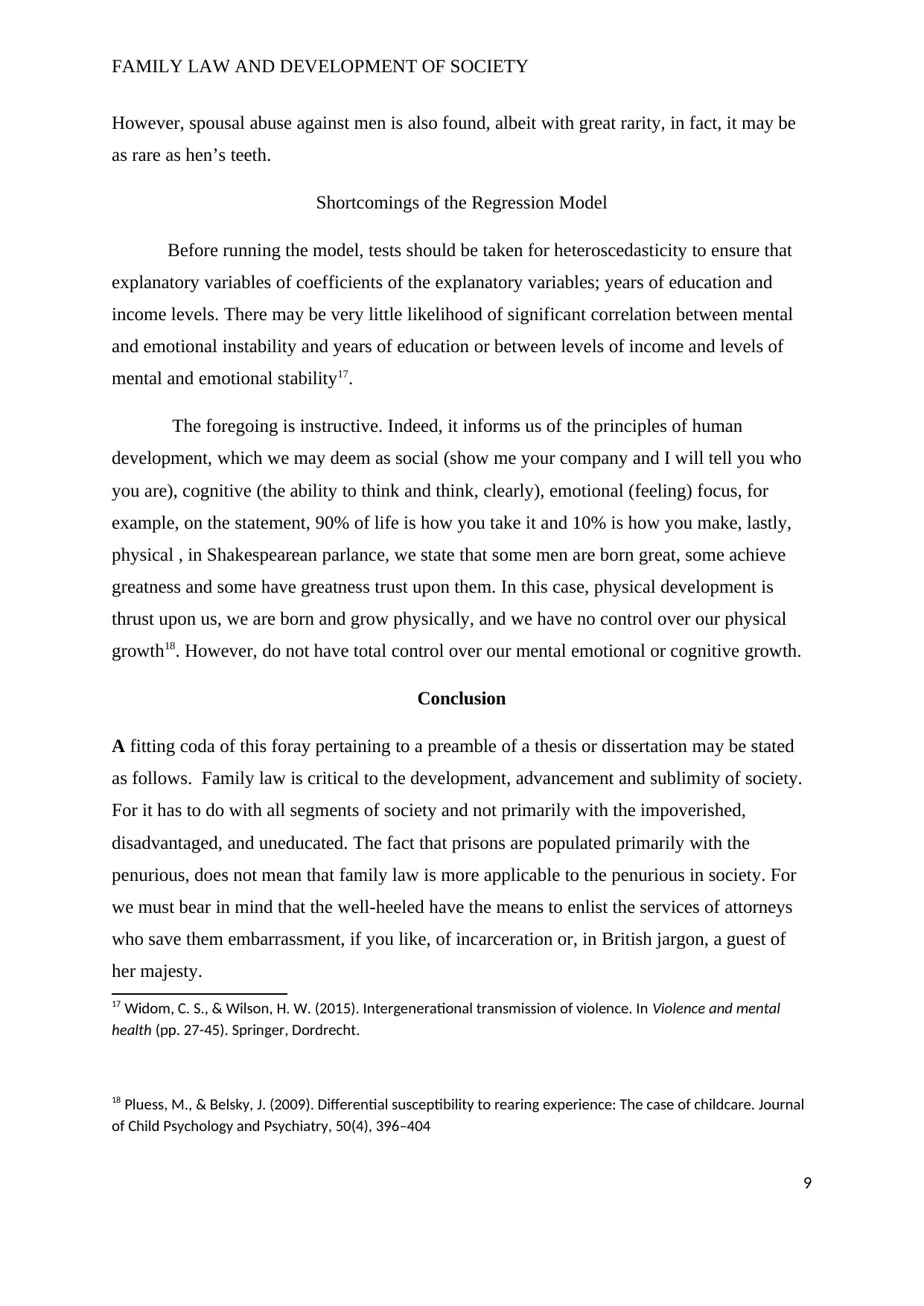
FAMILY LAW AND DEVELOPMENT OF SOCIETY
However, spousal abuse against men is also found, albeit with great rarity, in fact, it may be
as rare as hen’s teeth.
Shortcomings of the Regression Model
Before running the model, tests should be taken for heteroscedasticity to ensure that
explanatory variables of coefficients of the explanatory variables; years of education and
income levels. There may be very little likelihood of significant correlation between mental
and emotional instability and years of education or between levels of income and levels of
mental and emotional stability17.
The foregoing is instructive. Indeed, it informs us of the principles of human
development, which we may deem as social (show me your company and I will tell you who
you are), cognitive (the ability to think and think, clearly), emotional (feeling) focus, for
example, on the statement, 90% of life is how you take it and 10% is how you make, lastly,
physical , in Shakespearean parlance, we state that some men are born great, some achieve
greatness and some have greatness trust upon them. In this case, physical development is
thrust upon us, we are born and grow physically, and we have no control over our physical
growth18. However, do not have total control over our mental emotional or cognitive growth.
Conclusion
A fitting coda of this foray pertaining to a preamble of a thesis or dissertation may be stated
as follows. Family law is critical to the development, advancement and sublimity of society.
For it has to do with all segments of society and not primarily with the impoverished,
disadvantaged, and uneducated. The fact that prisons are populated primarily with the
penurious, does not mean that family law is more applicable to the penurious in society. For
we must bear in mind that the well-heeled have the means to enlist the services of attorneys
who save them embarrassment, if you like, of incarceration or, in British jargon, a guest of
her majesty.
17 Widom, C. S., & Wilson, H. W. (2015). Intergenerational transmission of violence. In Violence and mental
health (pp. 27-45). Springer, Dordrecht.
18 Pluess, M., & Belsky, J. (2009). Differential susceptibility to rearing experience: The case of childcare. Journal
of Child Psychology and Psychiatry, 50(4), 396–404
9
However, spousal abuse against men is also found, albeit with great rarity, in fact, it may be
as rare as hen’s teeth.
Shortcomings of the Regression Model
Before running the model, tests should be taken for heteroscedasticity to ensure that
explanatory variables of coefficients of the explanatory variables; years of education and
income levels. There may be very little likelihood of significant correlation between mental
and emotional instability and years of education or between levels of income and levels of
mental and emotional stability17.
The foregoing is instructive. Indeed, it informs us of the principles of human
development, which we may deem as social (show me your company and I will tell you who
you are), cognitive (the ability to think and think, clearly), emotional (feeling) focus, for
example, on the statement, 90% of life is how you take it and 10% is how you make, lastly,
physical , in Shakespearean parlance, we state that some men are born great, some achieve
greatness and some have greatness trust upon them. In this case, physical development is
thrust upon us, we are born and grow physically, and we have no control over our physical
growth18. However, do not have total control over our mental emotional or cognitive growth.
Conclusion
A fitting coda of this foray pertaining to a preamble of a thesis or dissertation may be stated
as follows. Family law is critical to the development, advancement and sublimity of society.
For it has to do with all segments of society and not primarily with the impoverished,
disadvantaged, and uneducated. The fact that prisons are populated primarily with the
penurious, does not mean that family law is more applicable to the penurious in society. For
we must bear in mind that the well-heeled have the means to enlist the services of attorneys
who save them embarrassment, if you like, of incarceration or, in British jargon, a guest of
her majesty.
17 Widom, C. S., & Wilson, H. W. (2015). Intergenerational transmission of violence. In Violence and mental
health (pp. 27-45). Springer, Dordrecht.
18 Pluess, M., & Belsky, J. (2009). Differential susceptibility to rearing experience: The case of childcare. Journal
of Child Psychology and Psychiatry, 50(4), 396–404
9
⊘ This is a preview!⊘
Do you want full access?
Subscribe today to unlock all pages.

Trusted by 1+ million students worldwide
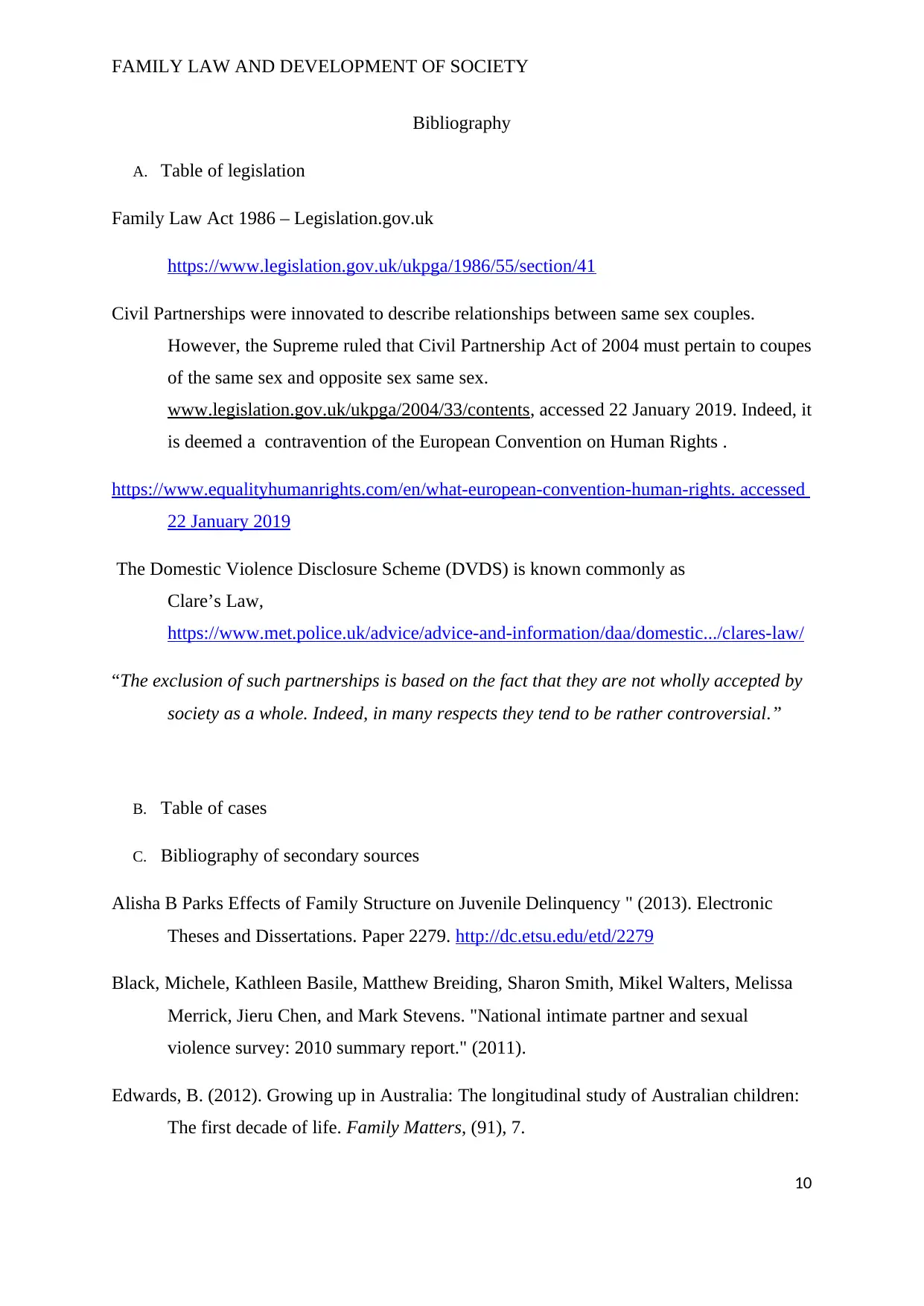
FAMILY LAW AND DEVELOPMENT OF SOCIETY
Bibliography
A. Table of legislation
Family Law Act 1986 – Legislation.gov.uk
https://www.legislation.gov.uk/ukpga/1986/55/section/41
Civil Partnerships were innovated to describe relationships between same sex couples.
However, the Supreme ruled that Civil Partnership Act of 2004 must pertain to coupes
of the same sex and opposite sex same sex.
www.legislation.gov.uk/ukpga/2004/33/contents, accessed 22 January 2019. Indeed, it
is deemed a contravention of the European Convention on Human Rights .
https://www.equalityhumanrights.com/en/what-european-convention-human-rights. accessed
22 January 2019
The Domestic Violence Disclosure Scheme (DVDS) is known commonly as
Clare’s Law,
https://www.met.police.uk/advice/advice-and-information/daa/domestic.../clares-law/
“The exclusion of such partnerships is based on the fact that they are not wholly accepted by
society as a whole. Indeed, in many respects they tend to be rather controversial.”
B. Table of cases
C. Bibliography of secondary sources
Alisha B Parks Effects of Family Structure on Juvenile Delinquency " (2013). Electronic
Theses and Dissertations. Paper 2279. http://dc.etsu.edu/etd/2279
Black, Michele, Kathleen Basile, Matthew Breiding, Sharon Smith, Mikel Walters, Melissa
Merrick, Jieru Chen, and Mark Stevens. "National intimate partner and sexual
violence survey: 2010 summary report." (2011).
Edwards, B. (2012). Growing up in Australia: The longitudinal study of Australian children:
The first decade of life. Family Matters, (91), 7.
10
Bibliography
A. Table of legislation
Family Law Act 1986 – Legislation.gov.uk
https://www.legislation.gov.uk/ukpga/1986/55/section/41
Civil Partnerships were innovated to describe relationships between same sex couples.
However, the Supreme ruled that Civil Partnership Act of 2004 must pertain to coupes
of the same sex and opposite sex same sex.
www.legislation.gov.uk/ukpga/2004/33/contents, accessed 22 January 2019. Indeed, it
is deemed a contravention of the European Convention on Human Rights .
https://www.equalityhumanrights.com/en/what-european-convention-human-rights. accessed
22 January 2019
The Domestic Violence Disclosure Scheme (DVDS) is known commonly as
Clare’s Law,
https://www.met.police.uk/advice/advice-and-information/daa/domestic.../clares-law/
“The exclusion of such partnerships is based on the fact that they are not wholly accepted by
society as a whole. Indeed, in many respects they tend to be rather controversial.”
B. Table of cases
C. Bibliography of secondary sources
Alisha B Parks Effects of Family Structure on Juvenile Delinquency " (2013). Electronic
Theses and Dissertations. Paper 2279. http://dc.etsu.edu/etd/2279
Black, Michele, Kathleen Basile, Matthew Breiding, Sharon Smith, Mikel Walters, Melissa
Merrick, Jieru Chen, and Mark Stevens. "National intimate partner and sexual
violence survey: 2010 summary report." (2011).
Edwards, B. (2012). Growing up in Australia: The longitudinal study of Australian children:
The first decade of life. Family Matters, (91), 7.
10
Paraphrase This Document
Need a fresh take? Get an instant paraphrase of this document with our AI Paraphraser
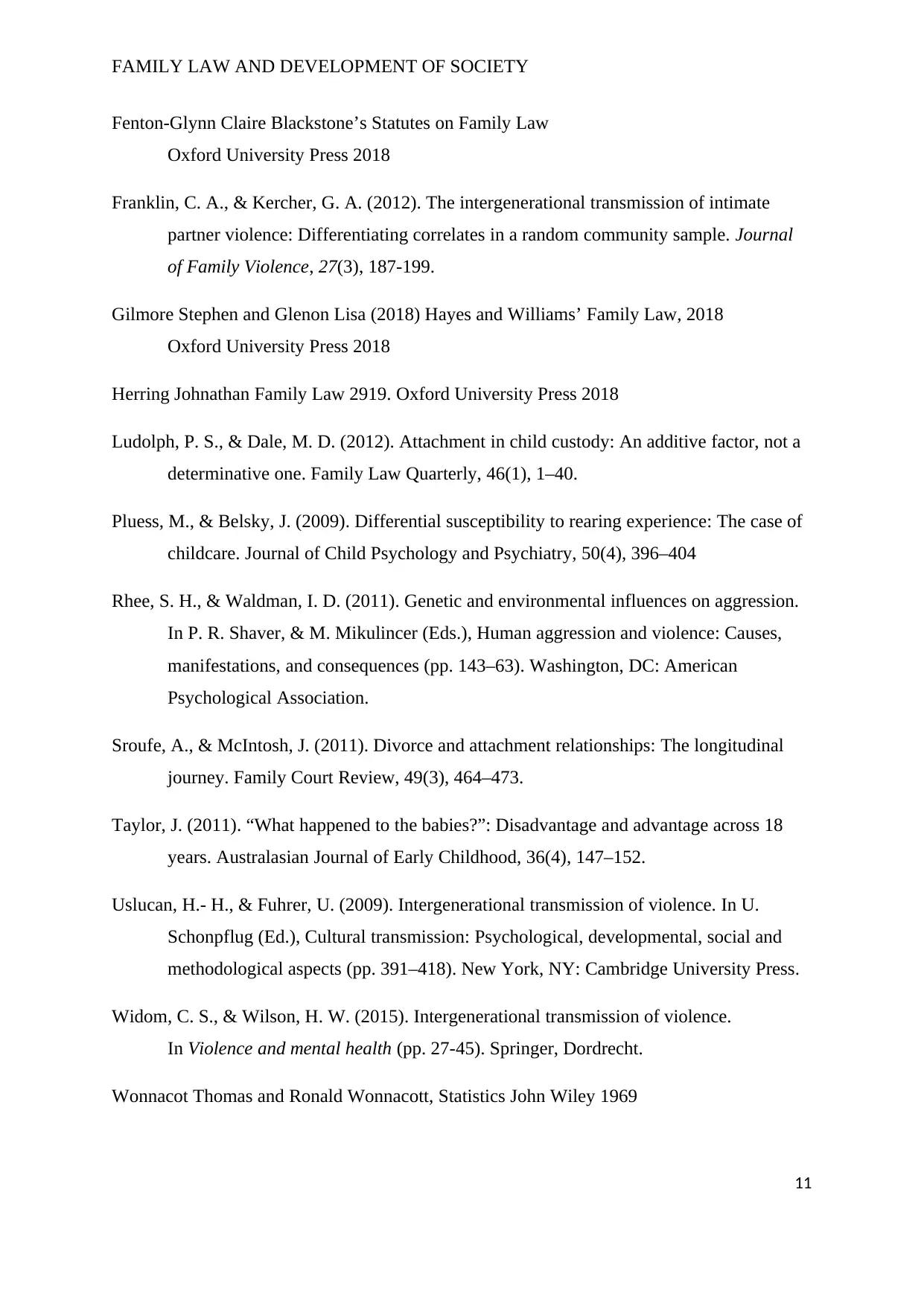
FAMILY LAW AND DEVELOPMENT OF SOCIETY
Fenton-Glynn Claire Blackstone’s Statutes on Family Law
Oxford University Press 2018
Franklin, C. A., & Kercher, G. A. (2012). The intergenerational transmission of intimate
partner violence: Differentiating correlates in a random community sample. Journal
of Family Violence, 27(3), 187-199.
Gilmore Stephen and Glenon Lisa (2018) Hayes and Williams’ Family Law, 2018
Oxford University Press 2018
Herring Johnathan Family Law 2919. Oxford University Press 2018
Ludolph, P. S., & Dale, M. D. (2012). Attachment in child custody: An additive factor, not a
determinative one. Family Law Quarterly, 46(1), 1–40.
Pluess, M., & Belsky, J. (2009). Differential susceptibility to rearing experience: The case of
childcare. Journal of Child Psychology and Psychiatry, 50(4), 396–404
Rhee, S. H., & Waldman, I. D. (2011). Genetic and environmental influences on aggression.
In P. R. Shaver, & M. Mikulincer (Eds.), Human aggression and violence: Causes,
manifestations, and consequences (pp. 143–63). Washington, DC: American
Psychological Association.
Sroufe, A., & McIntosh, J. (2011). Divorce and attachment relationships: The longitudinal
journey. Family Court Review, 49(3), 464–473.
Taylor, J. (2011). “What happened to the babies?”: Disadvantage and advantage across 18
years. Australasian Journal of Early Childhood, 36(4), 147–152.
Uslucan, H.- H., & Fuhrer, U. (2009). Intergenerational transmission of violence. In U.
Schonpflug (Ed.), Cultural transmission: Psychological, developmental, social and
methodological aspects (pp. 391–418). New York, NY: Cambridge University Press.
Widom, C. S., & Wilson, H. W. (2015). Intergenerational transmission of violence.
In Violence and mental health (pp. 27-45). Springer, Dordrecht.
Wonnacot Thomas and Ronald Wonnacott, Statistics John Wiley 1969
11
Fenton-Glynn Claire Blackstone’s Statutes on Family Law
Oxford University Press 2018
Franklin, C. A., & Kercher, G. A. (2012). The intergenerational transmission of intimate
partner violence: Differentiating correlates in a random community sample. Journal
of Family Violence, 27(3), 187-199.
Gilmore Stephen and Glenon Lisa (2018) Hayes and Williams’ Family Law, 2018
Oxford University Press 2018
Herring Johnathan Family Law 2919. Oxford University Press 2018
Ludolph, P. S., & Dale, M. D. (2012). Attachment in child custody: An additive factor, not a
determinative one. Family Law Quarterly, 46(1), 1–40.
Pluess, M., & Belsky, J. (2009). Differential susceptibility to rearing experience: The case of
childcare. Journal of Child Psychology and Psychiatry, 50(4), 396–404
Rhee, S. H., & Waldman, I. D. (2011). Genetic and environmental influences on aggression.
In P. R. Shaver, & M. Mikulincer (Eds.), Human aggression and violence: Causes,
manifestations, and consequences (pp. 143–63). Washington, DC: American
Psychological Association.
Sroufe, A., & McIntosh, J. (2011). Divorce and attachment relationships: The longitudinal
journey. Family Court Review, 49(3), 464–473.
Taylor, J. (2011). “What happened to the babies?”: Disadvantage and advantage across 18
years. Australasian Journal of Early Childhood, 36(4), 147–152.
Uslucan, H.- H., & Fuhrer, U. (2009). Intergenerational transmission of violence. In U.
Schonpflug (Ed.), Cultural transmission: Psychological, developmental, social and
methodological aspects (pp. 391–418). New York, NY: Cambridge University Press.
Widom, C. S., & Wilson, H. W. (2015). Intergenerational transmission of violence.
In Violence and mental health (pp. 27-45). Springer, Dordrecht.
Wonnacot Thomas and Ronald Wonnacott, Statistics John Wiley 1969
11
1 out of 11
Your All-in-One AI-Powered Toolkit for Academic Success.
+13062052269
info@desklib.com
Available 24*7 on WhatsApp / Email
![[object Object]](/_next/static/media/star-bottom.7253800d.svg)
Unlock your academic potential
Copyright © 2020–2025 A2Z Services. All Rights Reserved. Developed and managed by ZUCOL.